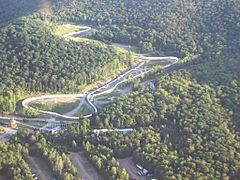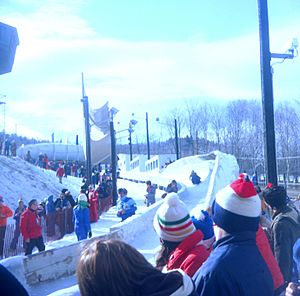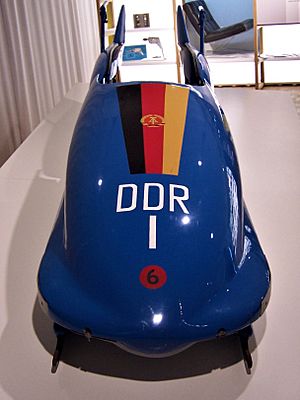Mt. Van Hoevenberg Olympic Bobsled Run facts for kids
Quick facts for kids |
|
|
Mt. Van Hoevenberg Olympic Bobsled Run
|
|

2005 aerial view of the current bobsleigh,
luge, and skeleton track |
|
| Location | 220 Bob Sled Run, vicinity of Lake Placid, New York |
|---|---|
| Area | 23 acres (9.3 ha) |
| NRHP reference No. | 10000008 |
| Added to NRHP | February 4, 2010 |
The Mt. Van Hoevenberg Olympic Bobsled Run is a special place in Lake Placid, New York. It's where athletes race down an icy track in sports like bobsleigh, luge, and skeleton. This famous track was used for the 1932 Winter Olympics and the 1980 Winter Olympics. It also hosted the only winter Goodwill Games in 2000.
This track was the first place outside of Europe to host the FIBT World Championships for bobsleigh in 1949. It also hosted the first FIL World Luge Championships outside Europe in 1983. The track you see today was finished in 2000. In 2010, it was added to the National Register of Historic Places because it's such an important part of history.
Contents
A Look Back: The Track's History
The first bobsled track here was built in 1930. It was made especially for the 1932 Winter Olympics. A German designer named Stanislaus Sentzytsky created it. His design was different from tracks in Europe. It was longer, steeper, and had sharper curves. This allowed for faster speeds and smoother rides.
After the American team won two gold medals and one silver in 1932, bobsledding became very popular in the U.S. American teams were top in the sport until 1956. Even today, parts of the original track are still used for training and fun rides.
Building the First Track
Before the 1932 Olympics, bobsled races happened on a steep hill nearby. People loved watching the fast sleds, even though some teams crashed. This first track only lasted one season.
The permanent track was built at Mount Van Hoevenberg between August and December 1930. It opened on Christmas Day that year. This first track was about 2.366 kilometers (1.47 miles) long. It had 26 curves and a big drop of 228 meters (748 feet).
Changes and Safety Improvements
After 1932, the track was made shorter. About 0.829 kilometers (0.515 miles) and ten curves were removed. The track became 1.537 kilometers (0.955 miles) long with 16 curves.
In 1949, the track hosted the first bobsleigh world championships outside Europe. Sadly, a Belgian athlete named Max Houben died during a practice run. This led to his team leaving the competition.
More safety improvements were made after another accident in 1966. These changes helped make the track safer for athletes.
The 1980 Olympics and New Tracks
For the 1980 Winter Olympics, a new, modern bobsleigh track was built. It was made of concrete and had artificial cooling to keep the ice perfect. This track was finished in 1979.
A separate luge track was also built for the 1980 Games. It was the first luge track in the United States. After the 1980 Olympics, both tracks hosted world championships in 1983. The old 1932 track was then used only for passenger rides.
The Modern Track and Future Plans
In the 1990s, skeleton racing started here. The bobsleigh track hosted its world championships in 1997. By the late 1990s, parts of both old tracks were taken down. A brand new track was built, opening in January 2000. This is the track used today.
Since 2006, the track has hosted the Chevy Geoff Bodine Bobsled Challenge. This event lets NASCAR drivers try bobsledding. It helps raise money for the Bo-Dyn Bobsled Project, which makes sleds for the U.S. team.
In 2009, this track made history again. It was the first track to host world championships for bobsleigh, luge, and skeleton all in the same year, outside of an Olympic year.
Looking ahead, the track might even be used for the 2026 Winter Olympics. It has been named a backup venue for the games in Italy.
Current Track Details
The track today is designed for speed and excitement. Here are some facts about it:
| Sport | Length | Turns | Grade |
|---|---|---|---|
| Bobsleigh and men's singles luge | 1.455 km (0.904 mi) | 20 | 9.8% |
| Skeleton | - | 19 | 9.8% |
| Luge - women's singles and men's doubles | 1.130 km (0.702 mi) | 17 | - |
- The track drops about 420 feet (128 meters) from start to finish.
Famous Turns
Many turns on the track have special names. These names often tell a story about the track's history or the area around it.
| Turn | Name | Why it's named that |
|---|---|---|
| 2 3 |
Cliffside | Named after an original curve that was next to a cliff. |
| 4 | Whiteface | Named after Whiteface Mountain in the Adirondack Mountains. Luge for women and doubles starts here. |
| 5 6 7 8 9 |
Devil's Highway | A series of quick, challenging curves. |
| 10 | Shady II | Named after an old curve that was always in the shadows. |
| 11 12 13 |
Labyrinth | Three fast curves, one after another, like a maze. |
| 14 | Benham's bend. | Named after Stanley Benham, a gold medalist in bobsleigh in 1949. |
| 15 16 |
Chicane | Two small, rolling curves that feel almost like a straight line if you drive them perfectly. |
| 17 18 19 |
Heart curve Trickle |
Shaped like a heart. "Trickle" is named after a race car driver who crashed here. The finish line for skeleton is after turn 19. |
| 20 | Finish | The very end of the track. |
Fastest Times
Athletes from all over the world have set amazing records on this track. Here are some of the fastest times:
| Sport | Record | Nation - athlete(s) | Date | Time (seconds) |
|---|---|---|---|---|
| Bobsleigh two-woman | Start | December 15, 2007 | 5.54 | |
| Bobsleigh two-woman | Track | December 15, 2007 | 56.94 | |
| Luge - men's singles | Start | David Möller - |
February 7, 2009 | 1.712 |
| Luge - men's singles | Track | Tucker West - |
December 5, 2014 | 51.002 |
| Luge - women's singles | Start | Tatjana Hüfner - |
February 6, 2009 | 6.350 |
| Luge - women's singles | Track | Summer Britcher - |
March 18, 2017 | 43.878 |
| Luge - men's doubles | Start | February 6, 2009 | 6.219 | |
| Luge - men's doubles | Track | February 6, 2009 | 43.641 | |
| Skeleton - men's | Track | Matthew Antoine - |
March 4, 2011 | 53.68 |
| Skeleton - women's | Track | Marion Trott - |
February 26, 2009 | 56.23 |
Past Tracks
The Mt. Van Hoevenberg track has changed a lot over the years.
The 1932 Olympic Track
The very first Olympic track in 1932 had 26 curves. Some of its famous turns included:
| Turn | Name | Why it was named that |
|---|---|---|
| 4 | Eyrle | - |
| 10 | Whiteface | Named after Whiteface Mountain. |
| 14 | Cliffside | Because it was located next to a cliff. |
| 19 | Shady Corner | This corner was always in the shadows. |
| 23 24 25 |
Zig-Zag | A series of three quick curves shaped like an "S". |
The 1980 Olympic Tracks
The bobsleigh track for the 1980 Winter Olympics was 1.557 kilometers (0.967 miles) long. It had 16 curves and a drop of 148 meters (486 feet).
The luge track for the 1980 Olympics had different starting points. For men's singles, it was 1.014 kilometers (0.630 miles) long with 14 curves. For women's singles and men's doubles, it was shorter, at 0.749 kilometers (0.465 miles) with 11 curves.
Major Competitions Hosted
This track has been home to many important international events:
- Winter Olympics: 1932, 1980
- FIBT World Championships (Bobsleigh and Skeleton): 1949, 1961, 1969, 1973, 1978, 1983, 1997 (men's skeleton), 2003 (Men's bobsleigh), 2009, 2012, 2025
- FIL World Luge Championships: 1983, 2009






